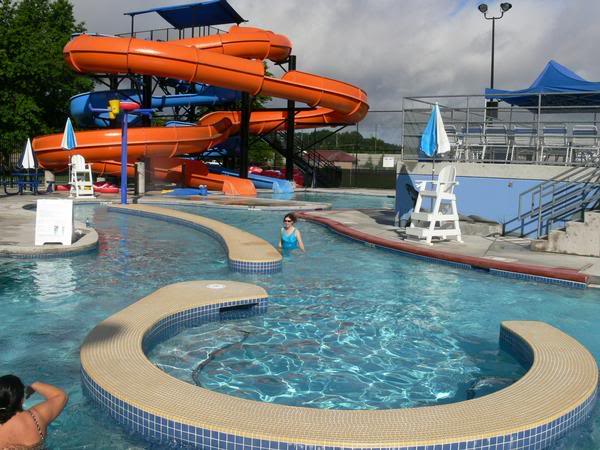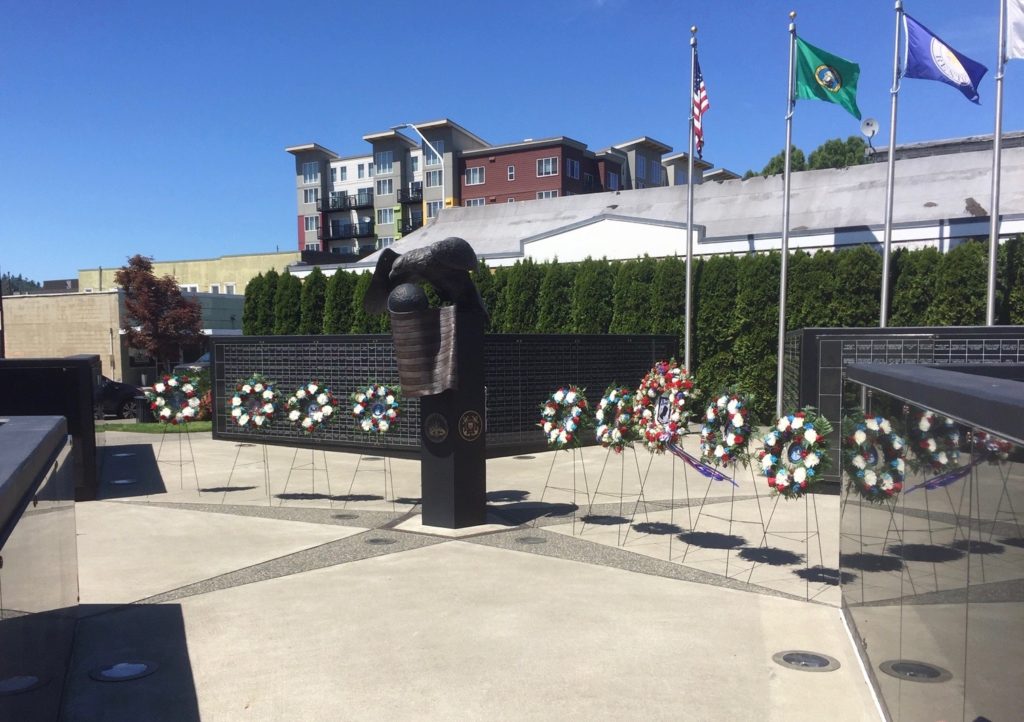I’ve depicted Henry Moses Aquatic Center in my yard sign and taken credit for helping get the aquatic center and Veteran Park built. Here is the history of getting these projects funded:
We closed our old Henry Moses Pool in the mid 1990s, after it began leaking 30,000 gallons of water per day. One of our wells was pouring replacement water into the pool at the rate of a fire hose. The pool was becoming impossible to heat, spilling chlorine into the ground, and potentially becoming a risk for catastrophic collapse. Replacing just the pool tank was not an option, since the work would trigger codes requiring that everything including the pool house be brought up to latest standards.
Hence, we were looking at a multi-million dollar investment. It was a time when the county was trying to off-load their “Forward-thrust” pools throughout the area because pools were expensive to operate even when they were not leaking water into the ground.
So we set about building a pool that could operate financially in the black, where admission fees would cover all the costs of operating the pool. To pay for life guards, energy, and maintenance costs, we needed to get admission fees up. We learned people would pay much more to enter a pool with amenities like slides, wave machines, and lazy rivers, and other interactive features. Such amenities only added about 20% to the price of the pool, but doubled or tripled the ticket revenue. Hence, our Henry Moses Aquatic Center was conceived. It would be too large for the old Henry Moses Pool location, so we moved it across the freeway near the community center, and built a much-requested skate park at the old pool site.
After we had designed the Henry Moses Aquatic Center we ran a ballot issue asking the public if they would approve an extra tax to fund it. The voters had given it a 57 % YES vote, but this was short of the 60% needed to pass a bond issue.
Then, we had a bigger construction year than we expected in 2001, and we ended up with five million dollars at the end of the year even after fully-funding our rainy-day fund.
I wanted to use the ending fund balance to build the Henry Moses Aquatic Center and the Veterans Memorial Park (which had begun raising private funds but needed city help for completion). I was Community Services Chair that year, which gave me extra conviction to get the Aquatic Center and Veterans Park completed. Council Members King Parker and Toni Nelson firmly agreed with me, but we struggled to get our final vote. After a long debate, that covered all other possible uses for the money (including Police Staffing which I helped make sure we had already funded), Toni, King and I broke through the block and got the rest of the council to go along with us. One finer point of the debate was the question of building the Aquatic Center as it is now, versus an indoor pool.
Several council members said they would prefer an indoor pool, but there was no way to pay for such a pool or to get such a pool to be financially self-sustaining, and therefore we would not have the budget to operate it. Paying for it would require also funding a huge building and HVAC system, which could double or triple the cost of the complex. But the real problem was the annual operation costs, which would be significantly higher because of heating and maintaining a large building subject to constant high humidity, AND paying for staff and pool maintenance year round when swimmers drop off dramatically in the winter. Summer swims would also drop off, as people like to swim outdoors in the summer. So I helped promote a compromise, which later came into play in winning our votes. I supported slightly revising our plan to build a foundation under the pool deck around our lap pool, that could support a building if we decide to cover that one part of the aquatic center in the future. That foundation is in there if we ever find the money and public support to run an indoor pool.
Volunteers had been raising and donating money to the Veterans Memorial Park, but to get construction kicked off they needed a major donation from the city. This was part of the package I supported.
Here is an excerpt from the Council Committe of the Whole minutes of April 22, 2002, the night of our final debate and action on the Henry Moses Pool and Veteran Memorial Park:
“Councilman Corman stated that he favors going forward this year with the Veterans Memorial Park, the swimming pool, and doing some work on the Pavilion Building. He explained that since the City aggressively staffs its Economic Development Department, the City has experienced significant economic growth, and the combination of economic growth and a conservative Budget resulted in excess funds. Stating that the City has studied the swimming pool issue in depth, Mr. Corman expressed his support for the swimming pool as proposed. He pointed out that this can be viewed as a restoration back to the community of a facility that Renton traditionally has had. Mr. Corman also commented on Police Department staffing, and noted that the City is going to add seven police staff members this year.”
The Council Meeting minutes from that same night, where we took final action, can be found here.
From the time we built the aquatic center it has operated successfully in the black (paid for its own operation and maintenance), generating a small surplus of funding each year of around $50,000. We invest this money back in to the pool each year to add features and make the complex more fun.
Below is a newspaper article from the previous month with more information about how the surplus divided the council.
King County Journal, 3/23/2002
Surplus divides Renton council – Mayor (Tanner) wants to build pool, finish projects with extra cash, but some officials hesitant
Wendy Giroux
RENTON — King County and state leaders have had to slash their budgets, but Renton city officials are trying to decide how to spend a $5.4 million surplus from last year.
Mayor Jesse Tanner wants to put $2 million of it toward a new public swimming pool and the rest toward two other building projects, but the City Council would have to issue $6 million in bonds to complete the financing on two of the projects.
Three council members said this week that they’re behind Tanner’s proposal, but the other four don’t entirely agree with his ideas.
For instance, Councilman Dan Clawson said he might be interested in saving some of the surplus in case it’s needed more urgently.
“I think with all the uncertainty right now, we’ve got to be very careful with how we allocate general fund dollars,” Clawson said at the council’s Finance Committee meeting Monday.
“Just because something’s cheap doesn’t mean you go out and buy it on your credit card,” he said. “This is not a one-time expenditure. It’s a 20-year commitment.”
But Jay Covington, Renton’s chief administrative officer, said the economic downturn means now is a good time to get cheap bids from contractors and take advantage of low interest rates.
Councilman King Parker agreed.“It’s my feeling that today is the day to make this happen,” said Parker, who is chairman of the Finance Committee. “We’re very fortunate to have the excess that we have.”
The city has such a large fund balance because it spent less than budgeted, and took in more revenue than anticipated, said Victoria Runkle, finance administrator.
The city received about $2 million more than expected from utility taxes because of the rise in energy prices, about $1 million more than budgeted in real estate excise taxes, and about $685,000 more than expected from building permit fees, Runkle said.
The $5.4 million surplus — about 3 percent of the total budget — is over and above the money Renton has set aside in reserve funds. For instance, the city has $4.9 million in a “rainy day fund,” Covington said.
Tanner’s plan for the $5.4 million surplus calls for:
* Spending $2 million of that surplus, and issuing $3 million in councilmanic bonds (issued by a vote of the City Council), to build a new outdoor pool at the community center. The city’s old outdoor pool at Liberty Park was closed in 1997 because of leaking, and later filled in and made into a skateboard park.
* Spending another $2 million of the surplus, and issuing another $3 million in councilmanic bonds, to build a park maintenance facility. The new building would consolidate two outdated, inadequate facilities used to store and work on equipment.
* Adding $1 million of the surplus to the $2.3 million the city already has set aside for the pavilion building, adjacent to the Piazza at South Third Street and Burnett Avenue South. For four years, city leaders have planned to raze and rebuild the structure.* Spending $389,000 — in addition to $25,000 already earmarked and about $60,000 raised by citizens — to finish Veterans Memorial Park. Council President Toni Nelson and Councilman Randy Corman weren’t at the Finance Committee meeting, but later said they support the mayor’s proposals.“I think if we just curtail everything new and nice, we’d still have fed-up taxpayers and we wouldn’t be giving them the amenities they deserve,” said Corman, who has posted the pool plans on his refrigerator at home. “I’m really confident we can get this done.” Councilwoman Kathy Koelker-Wheeler said Tuesday that she, too, is interested in funding a pool, but would like to see a less expensive proposal. And she wants more information on all of the mayor’s proposals, particularly the pavilion building.
“I want to see the whole package,” Koelker-Wheeler said. “I want to know how much it’s going to cost us now and in the future, and I’m not inclined to spend a whole lot of money in this economy.”




Leave a Reply